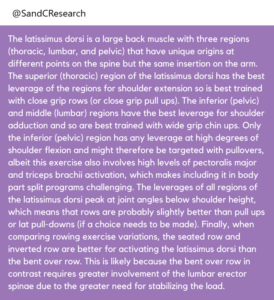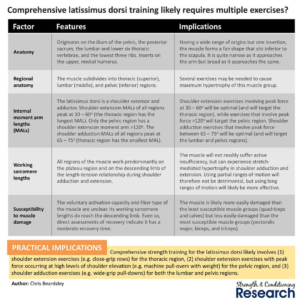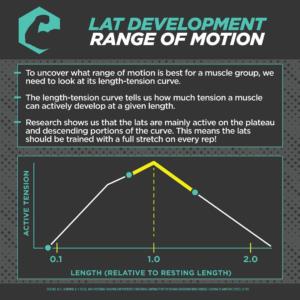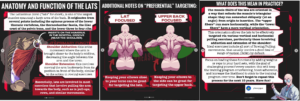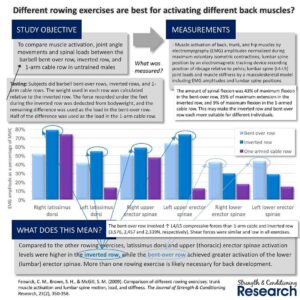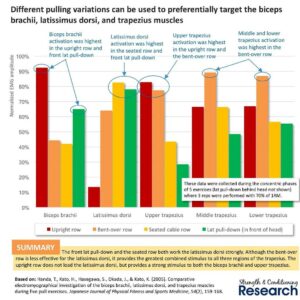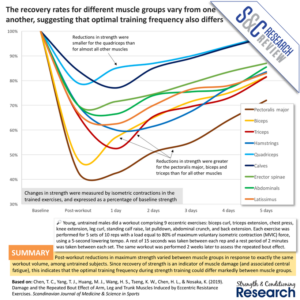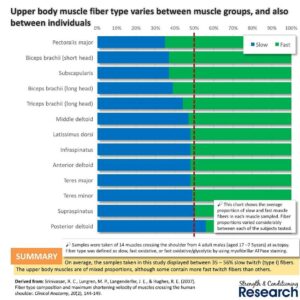LATISSIMUS DORSI
Click on Image to Enlarge
TRAINING
Upper – Superior – Thoracic:
– best leverage for shoulder extension; close grips: rows, pullups, chinups, lat pulldowns
Middle – Lumbar:
– best leverage for shoulder ad-duction; wider grips: pullups, lat pulldowns
Lower – Inferior – Pelvic:
– best leverage for shoulder ad-duction; wider grip pullups, lat pulldowns
– best leverage for shoulder extension and high degrees of flexion; close grip lat pulldowns and chins
STRETCH THE PECS BETWEEN SETS OF LAT EXERCISES
Acute effects of antagonist static stretching in the inter-set rest period on repetition performance and muscle activation – Miranda – 2015
Procedure
– Investigate the effects of antagonist passive static stretching (AS) during the inter-set rest period on repetition performance and muscle activation; 10 trained men
(1) Passive recovery (PR) – Seated Row (SR) 3×10 to failure; 2 min. rest interval between sets without pre-exercise stretching
(2) Passive Static Stretching (AS) – 40 sec of stretching pectoralis major prior to each set of SR.
Results
LATISSIMUS DORSI – REVIEW – 2022
– Including Moment Arm Studies
Latissimus dorsi – May 23, 2022 – Chris Beardsley
– three main regions (thoracic, lumbar, and pelvic) that have unique origins at different points along the spine but the same insertion on the humerus of the upper arm
#1. Internal moment arm lengths
– The 3 regions of the latissimus dorsi have different internal moment arm lengths from one another.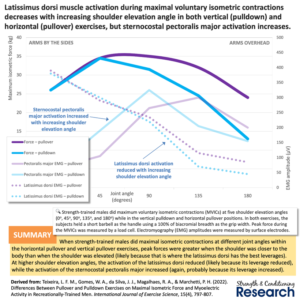
– According to the principle of neuromechanical matching, this means that the regions will contribute differently to different exercises and movements.
(1) Superior (thoracic) region has the best leverage for shoulder extension and is therefore best trained with close grip rows, close grip pull ups or lat pulls
(2-3) Inferior (pelvic) and Middle (lumbar) regions have the best leverage for shoulder adduction and are therefore best trained with wide grip chin ups or lat pulls
– Only the inferior (pelvic) region has meaningful leverage at high degrees of shoulder flexion and might therefore be targeted with close grip chins, lat pulldowns and pullovers.
– For both shoulder extension and shoulder adduction, the peak leverages for all regions of the latissimus occur below shoulder height (90 degrees).
– This is why rowing exercises are probably better for latissimus dorsi development than vertical pulling exercises.
– Recent research has confirmed that the latissimus dorsi is more strongly activated at lower levels of shoulder elevation in both lat pull-downs and pullover exercises.
#2. Pullover exercise variations
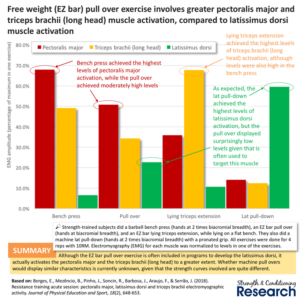 – Although the machine pullover exercise might be a suitable exercise variation for preferentially targeting the lower region of the latissimus dorsi, the pectoralis major and triceps brachii muscles are also highly active in pullover variations (although the use of free weights likely enhances the triceps brachii involvement since an elbow extension moment is needed to hold the barbell in position as well as the shoulder extension moment that acts to move the barbell). The use of pressing muscles in this exercise may well be a disadvantage when following a body part split routine.
– Although the machine pullover exercise might be a suitable exercise variation for preferentially targeting the lower region of the latissimus dorsi, the pectoralis major and triceps brachii muscles are also highly active in pullover variations (although the use of free weights likely enhances the triceps brachii involvement since an elbow extension moment is needed to hold the barbell in position as well as the shoulder extension moment that acts to move the barbell). The use of pressing muscles in this exercise may well be a disadvantage when following a body part split routine.
#3. Bent Over BB Row vs. Other Rows
(1) Bent over BB Row: allows a large amount of weight to be used, it doesn’t necessarily translate to an effective stimulus for the lats. The inverted row is superior because it allows a greater focus on this area of the back, while the bent over row requires a great deal of support from the lumbar erectors
(2) Bent over BB Row: due to greater involvement of muscles lower down on the back (middle and lower traps), it doesn’t activate the lats as effectively as the lat pull-down or seated row.
#4. Recovery capacity
– The latissimus dorsi recovers more quickly than some muscles of the upper body that are famous for recovering slowly after a workout (the triceps brachii, the pectoralis major, and the biceps brachii) but more slowly than many muscles of the lower body (the quadriceps and calves). This suggests that optimal training frequency for a given level of workout volume will be higher than for pressing workouts but lower than for lower body workouts.
– The latissimus dorsi likely recovers faster than the triceps brachii, the pectoralis major, and the biceps brachii because these muscles contain a higher proportion of fast twitch muscle fibers. Fast twitch muscle fibers are more easily damaged after exercise because they have fewer mitochondria. Thus, they experience greater damage from the calpains (proteases) that are released in response to the influx of calcium ions during exercise.
